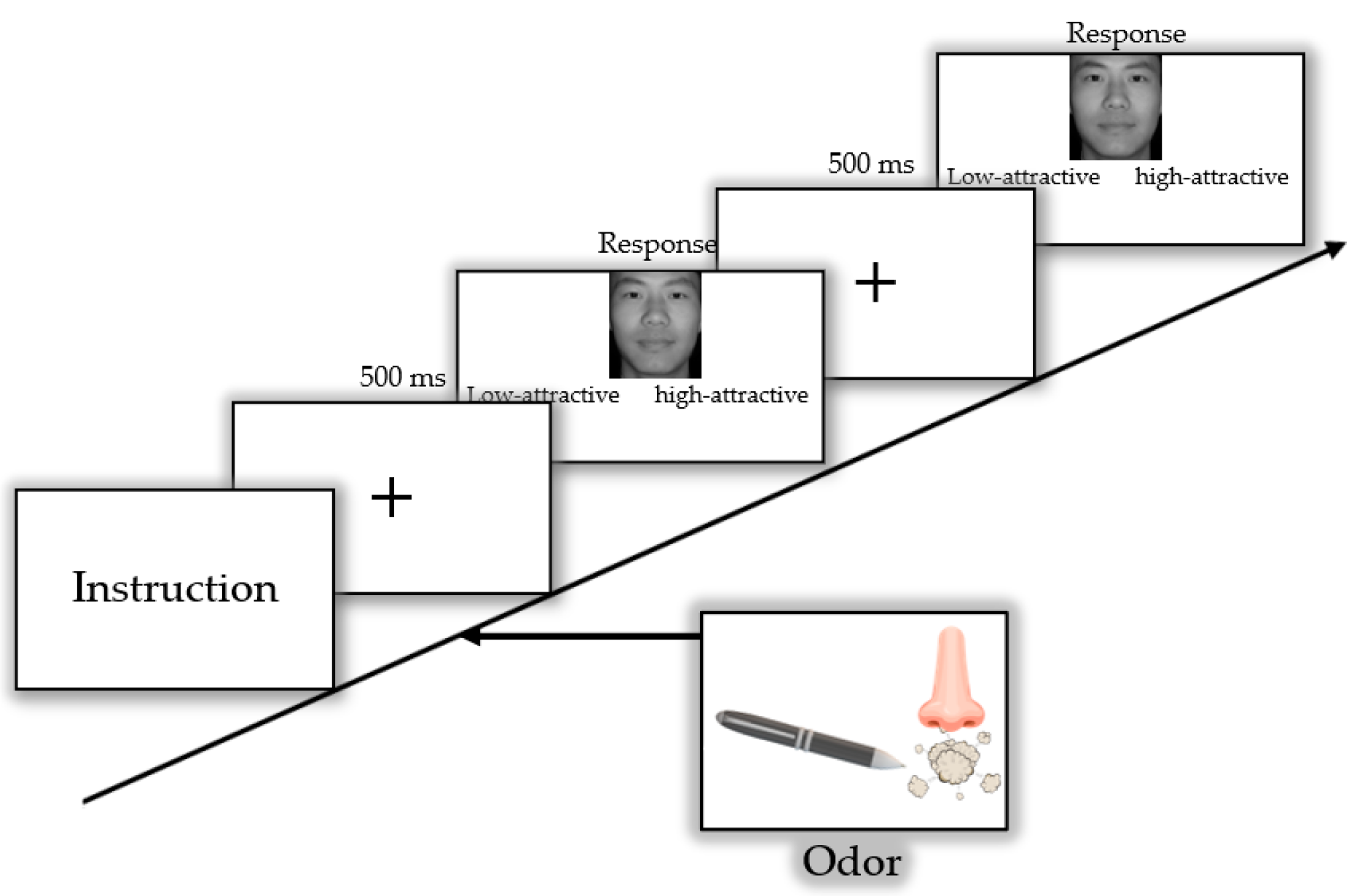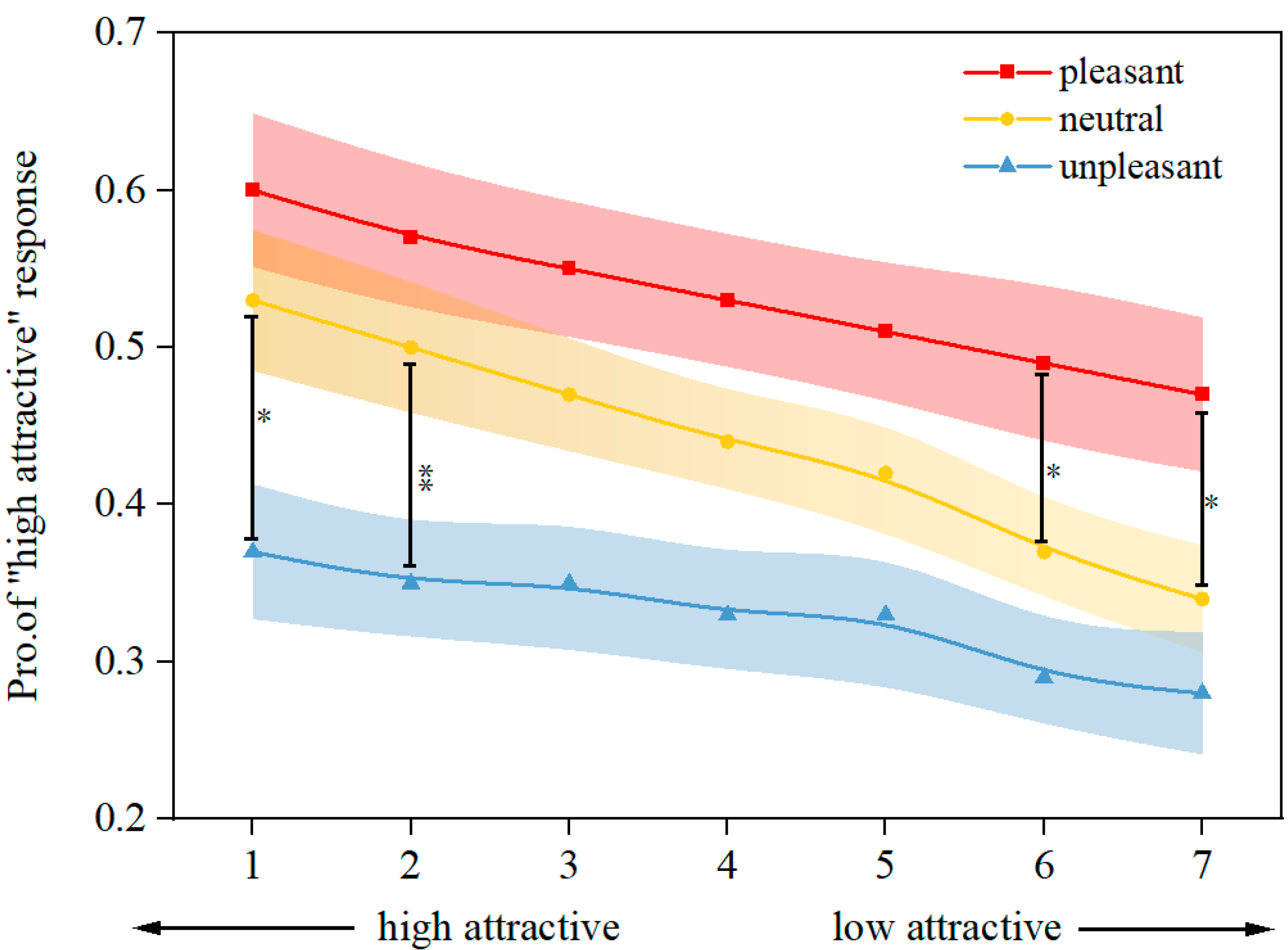The Effect of Odor Valence on Facial Attractiveness Judgment: A Preliminary Experiment
Abstract
:1. Introduction
2. Method
2.1. Participants
2.2. Materials and Measures
2.2.1. Olfactory Stimuli
2.2.2. Visual Stimuli
2.2.3. Questionnaire
2.3. Procedure
2.4. Data Analysis
3. Results
3.1. Odor-Rating Results
3.2. Odor Valence and Morphing Levels Influence Facial Attractiveness Judgment
3.3. Odor Valence and Gender Affect Facial Attractiveness Judgment
4. Discussion
5. Conclusions
Author Contributions
Funding
Institutional Review Board Statement
Informed Consent Statement
Data Availability Statement
Conflicts of Interest
References
- Crofton, G.C. What is Good is Beautiful. Sociometry 1977, 40, 85–90. [Google Scholar]
- Rhodes, G. The evolutionary psychology of facial beauty. Annu. Rev. Psychol. 2006, 57, 199–226. [Google Scholar] [CrossRef] [PubMed] [Green Version]
- Poutvaara, P. Facial appearance and leadership: An overview and challenges for new research. Leadersh. Q. 2014, 25, 801–804. [Google Scholar] [CrossRef]
- Liu, S.; Han, S.; Wang, X.; Li, W.; Zhang, L. Review and Progress of Models of Social Perceptions of Faces. J. Psychol. Sci. 2020, 43, 132–143. [Google Scholar]
- Little, A.C.; Jones, B.C.; Debruine, L.M. Facial attractiveness: Evolutionary based research. Philos. Trans. R. Soc. Lond. 2011, 366, 1638–1659. [Google Scholar] [CrossRef] [Green Version]
- Kou, H.; Xie, Q.; Bi, T. Mechanisms for the Cognitive Processing of Attractiveness in Adult and Infant Faces: From the Evolutionary Perspective. Front. Psychol. 2020, 11, 436. [Google Scholar] [CrossRef] [Green Version]
- Wen, L.; Moallem, I.; Paller, K.A.; Gottfried, J.A. Subliminal Smells can Guide Social Preferences. Psychol. Sci. 2007, 18, 1044–1049. [Google Scholar]
- Oleszkiewicz, A.; Suhle, P.; Haehner, A.; Croy, I. Prior exposure to Hedione, a model of pheromone, does not affect female ratings of male facial attractiveness or likeability. Physiol. Behav. 2021, 238, 113458. [Google Scholar] [CrossRef]
- McGlone, F.; Österbauer, R.A.; Demattè, L.M.; Spence, C. The Crossmodal Influence of Odor Hedonics on Facial Attractiveness: Behavioural and fMRI Measures. In Functional Brain Mapping and the Endeavor to Understand the Working Brain; IntechOpen Limited: London, UK, 2013. [Google Scholar]
- Bushdid, C.; Magnasco, M.O.; Vosshall, L.B.; Keller, A. Humans Can Discriminate More than 1 Trillion Olfactory Stimuli. Science 2014, 343, 1370–1372. [Google Scholar] [CrossRef] [Green Version]
- Spence, C. The scent of attraction and the smell of success: Crossmodal influences on person perception. Cogn. Res. Princ. Implic. 2021, 6, 1–33. [Google Scholar] [CrossRef]
- Syrjnen, E.; Liuzza, M.T.; Fischer, H.; Olofsson, J.K. Do Valenced Odors and Trait Body Odor Disgust Affect Evaluation of Emotion in Dynamic Faces? Perception 2017, 46, 1412–1426. [Google Scholar] [CrossRef] [PubMed] [Green Version]
- Sterbauer, M.L.D.R.; Spence, C. Olfactory Cues Modulate Facial Attractiveness. Chem. Senses 2007, 32, 603–610. [Google Scholar]
- Seubert, J.; Gregory, K.M.; Chamberland, J.; Dessirier, J.-M.; Lundström, J.N. Odor Valence Linearly Modulates Attractiveness, but Not Age Assessment, of Invariant Facial Features in a Memory-Based Rating Task. PLoS ONE 2014, 9, e98347. [Google Scholar] [CrossRef] [PubMed]
- Cook, S.; Kokmotou, K.; Soto, V.; Wright, H.; Fallon, N.; Thomas, A.; Giesbrecht, T.; Field, M.; Stancak, A. Simultaneous odour-face presentation strengthens hedonic evaluations and event-related potential responses influenced by unpleasant odour. Neurosci. Lett. 2018, 672, 22–27. [Google Scholar] [CrossRef] [PubMed] [Green Version]
- Bensafi, M.; Pierson, A.; Rouby, C.; Farget, V.; Bertrand, B.; Vigouroux, M.; Jouvent, R.; Holley, A. Modulation of visual event-related potentials by emotional olfactory stimuli. Clin. Neurophysiol. 2002, 32, 335–342. [Google Scholar] [CrossRef]
- Chen, Y.C.; Spence, C. Assessing the Role of the ‘Unity Assumption’ on Multisensory Integration: A Review. Front. Psychol. 2017, 8, 445. [Google Scholar] [CrossRef] [Green Version]
- Zhou, W.; Feng, G. Olfactory Perception and Its Interplays with the Emotional System. Adv. Psychol. Sci. 2012, 20, 2–9. [Google Scholar] [CrossRef]
- Kahnt, T.; Heinzle, J.; Park, S.Q.; Romo, H.R. The neural code of reward anticipation in human orbitofrontal cortex. Proc. Natl. Acad. Sci. USA 2010, 107, 6010–6015. [Google Scholar] [CrossRef] [Green Version]
- Apicella, C.L.; Little, A.C.; Marlowe, F.W. Facial averageness and attractiveness in an isolated population of hunter-gatherers. Perception 2007, 36, 1813–1820. [Google Scholar] [CrossRef]
- Zhou, W.; Chen, D. Fear-Related Chemosignals Modulate Recognition of Fear in Ambiguous Facial Expressions. Psychol. Sci. 2009, 20, 177–183. [Google Scholar] [CrossRef]
- Groot, J.; Kirk, P.A.; Gottfried, J.A. Titrating the Smell of Fear: Initial Evidence for Dose-Invariant Behavioral, Physiological, and Neural Responses. Psychol. Sci. 2021, 4, 558–572. [Google Scholar] [CrossRef] [PubMed]
- Olson, I.R.; Marshuetz, C. Facial attractiveness is appraised in a glance. Emotion 2005, 5, 498–502. [Google Scholar] [CrossRef] [PubMed]
- Schacht, A.; Werheid, K.; Sommer, W. The appraisal of facial beauty is rapid but not mandatory. Cogn. Affect. Behav. Neurosci. 2008, 8, 132–142. [Google Scholar] [CrossRef] [PubMed] [Green Version]
- Clark, A.P.; Howard, K.L.; Woods, A.T.; Penton-Voak, I.S.; Neumann, C. Why rate when you could compare? Using the “EloChoice” package to assess pairwise comparisons of perceived physical strength. PLoS ONE 2018, 13, e0190393. [Google Scholar] [CrossRef] [Green Version]
- Burton, N.; Burton, M.; Dan, R.; Sutherland, C.; Rhodes, G. Best-worst scaling improves measurement of first impressions. Cogn. Res. Princ. Implic. 2019, 4, 1–10. [Google Scholar] [CrossRef]
- Cohen, J. Statistical Power Analysis for the Behavioral Sciences, 2nd ed.; Taylor & Francis Group: New York, NY, USA, 1988. [Google Scholar]
- Barz, S.; Hummel, T.; Pauli, E.; Majer, M.; Lang, C.J.G.; Kobal, G. Chemosensory event-related potentials in response to trigeminal and olfactory stimulation in idiopathic Parkinson’s disease. Neurology 1997, 49, 1424–1431. [Google Scholar] [CrossRef]
- Lehrner, J.; Marwinski, G.; Lehr, S.; Johren, P.; Deecke, L. Ambient odors of orange and lavender reduce anxiety and improve mood in a dental office. Physiol. Behav. 2005, 86, 92–95. [Google Scholar] [CrossRef]
- Gong, X.; Huang, Y.; Wang, Y.; Luo, Y. Revision of the Chinese Facial Affective Picture System. Chin. Ment. Health J. 2011, 25, 40–46. [Google Scholar]
- Watson, D.; Tellegen, A. Toward a consensual structure of mood. Psychol. Bull. 1985, 98, 219–235. [Google Scholar] [CrossRef]
- Huang, L.; Yang, T.; Ji, Z. Applicability of the Positive and Negative Affect Sacle in Chinese. Chin. Ment. Health J. 2004, 17, 54–56. [Google Scholar]
- Davis, J. The Relationship Between Precision-Recall and ROC Curves. In Proceedings of the 23th International Conference on Machine Learning, Pittsburgh, PA, USA, 25–29 June 2006; p. 1154. [Google Scholar]
- Novak, L.R.; Gitelman, D.R.; Schulyer, B.; Li, W. Olfactory-visual integration facilitates perception of subthreshold negative emotion. Neuropsychologia 2015, 77, 288–297. [Google Scholar] [CrossRef] [PubMed] [Green Version]
- Zhou, W.; Jiang, Y.; He, S.; Chen, D. Olfaction modulates visual perception in binocular rivalry. Curr. Biol. 2010, 20, 1356–1358. [Google Scholar] [CrossRef] [PubMed]
- Rinaldi, L.; Maggioni, E.; Olivero, N.; Maravita, A.; Girelli, L. Smelling the Space Around Us: Odor Pleasantness Shifts Visuospatial Attention in Humans. Emotion 2018, 18, 971–979. [Google Scholar] [CrossRef] [PubMed]
- Chen, K.; Zhou, B.; Chen, S.; He, S.; Zhou, W. Olfaction spontaneously highlights visual saliency map. Proc. R. Soc. B Biol. Sci. 2013, 280, 1729. [Google Scholar] [CrossRef] [PubMed]
- Seo, H.S.; Roidl, E.; Muller, F.; Negoias, S. Odors enhance visual attention to congruent objects. Appetite 2010, 54, 544–549. [Google Scholar] [CrossRef]
- Zhang, Z.; Deng, Z. Gender, facial attractiveness, and early and late event-related potential components. J. Integr. Neurosci. 2012, 11, 477–487. [Google Scholar] [CrossRef]
- Oh, D.W.; Buck, E.A.; Todorov, A. Revealing Hidden Gender Biases in Competence Impressions of Faces. Psychol. Sci. 2019, 30, 65–79. [Google Scholar] [CrossRef] [Green Version]





| Pleasant Odor Mean (SD) | Unpleasant Odor Mean (SD) | t | |
|---|---|---|---|
| Familiarity | 6.32(1.07) | 5.57(1.75) | 1.71 |
| Intensity | 6.60(1.19) | 7.01(1.33) | −1.33 |
| Pleasantness | 6.40(1.38) | 1.90(1.14) | 11.89 *** |
Publisher’s Note: MDPI stays neutral with regard to jurisdictional claims in published maps and institutional affiliations. |
© 2022 by the authors. Licensee MDPI, Basel, Switzerland. This article is an open access article distributed under the terms and conditions of the Creative Commons Attribution (CC BY) license (https://creativecommons.org/licenses/by/4.0/).
Share and Cite
Feng, G.; Lei, J. The Effect of Odor Valence on Facial Attractiveness Judgment: A Preliminary Experiment. Brain Sci. 2022, 12, 665. https://doi.org/10.3390/brainsci12050665
Feng G, Lei J. The Effect of Odor Valence on Facial Attractiveness Judgment: A Preliminary Experiment. Brain Sciences. 2022; 12(5):665. https://doi.org/10.3390/brainsci12050665
Chicago/Turabian StyleFeng, Guo, and Jiawei Lei. 2022. "The Effect of Odor Valence on Facial Attractiveness Judgment: A Preliminary Experiment" Brain Sciences 12, no. 5: 665. https://doi.org/10.3390/brainsci12050665
APA StyleFeng, G., & Lei, J. (2022). The Effect of Odor Valence on Facial Attractiveness Judgment: A Preliminary Experiment. Brain Sciences, 12(5), 665. https://doi.org/10.3390/brainsci12050665






